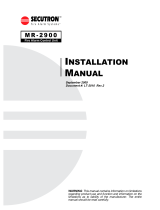Page is loading ...

1 LT-6108 rev 2.1
Wiring SPLIT-AMP-CAP-KIT
For more information, see the following documents:
• LT-6094: the application note for SPLIT-AMP-CAP-KIT
• The manual included with the monitor module
1.1 Remove the Jumper on MIX-M500SAP(A) or MRI-M500SAP(A)
If you are using the Advanced Protocol MIX-M500SAP(A) or MRI-M500SAP(A) for speaker
applications with the Mircom QX series of amplifiers, follow these instructions to remove
jumper J1. The jumper location is shown in Figure 1.
1. Insert a small flat screwdriver into the hole at the top of the unit.
2. Use the screwdriver to push the jumper out through the slot shown in Figure 1. You do
not need to open the cover.
3. Discard the jumper.
Figure 1 Remove and discard jumper on MIX-M500SAP(A) and MRI-M500SAP(A)
Note: In this document, monitor module refers to any of the following:
• MIX-M500SAP(A)
• MIX-M500S(A)
• MRI-M500SAP(A)
• MRI-M500S(A)
i
Jumper J1
1. Insert a small at-
head screwdriver
into this hole.
2. Push the jumper
out of this slot.

LT-6108 rev 2.1 2
1.2 Wiring the Monitor Modules
Figure 2 shows the wiring for the monitor modules.
Figure 2 Wiring the modules
1.3 Wiring the Capacitors
Figure 3 SPLIT-AMP-CAP-KIT
The class A audio circuit for suites requires 2 SPLIT-AMP-CAP-KIT capacitors for every
monitor module. The class B circuits do not require capacitors.
1. Wire one capacitor to terminals T6 and T9.
2. Wire the other capacitor to terminals T7 and T8.
BP BP
00uF35V 100uF35V
uF35V
BP
End of line resistor
plate with 22 kΩ or
10 kΩ resistor
End of line resistor
plate with 47 kΩ
resistor
Class B audio
circuit for other
areas
Class B audio bus
2x non-polarized 100 μF
35V capacitors
Primary path
Class A audio
circuit for suites
Alternate path
Data communication link
Wiring for:
MIX-M500SAP(A)
MIX-M500S(A)
MRI-M500SAP(A)
MRI-M500S(A)
BP BP
00uF35V 100uF35V
SPLIT-AMP-CAP-KIT comes with 20
non-polarized 100 μF 35V capacitors
that have been modified to eliminate issues in
the field.
/


